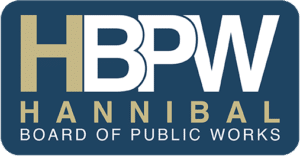Please click on the desired link below to view or print the Hannibal Board of Public Works rate structure for electric, water, and wastewater charges or for general fees and charges.
Effective Dates stated on each form
- FY24 Schedule of Rates and Fees - Effective 10/03/2023
Residential Rate
A residential electrical rate is established to allocate costs to those domestic users, defined as an individual or family occupant of a residential premise, used for non-business, non-commercial, or non-industrial purpose. The total cost to the residential customer will consist of a "Monthly Customer Charge" and a "per KWH" charge.
Commercial Rate
Single Phase - Available to any non-residential customer. Includes service at one location for general service as 60 cycle, single-phase service through one meter at the secondary voltage available from the electric distribution system at the customer's location.
Three Phase - Available to any non-residential customer. Includes service at one location for general service as 60 cycle, three-phase service through one meter at the secondary voltage available from the electric distribution system at the customer's location.
Industrial Rate
For any customer with a peak monthly energy demand during the most recent 12 month review period for 100kW or more at any load factor, or a peak energy demand of 50 kW or more and a load factor in excess of 45%. Includes service at one location or multiple locations through multiple meters as 60 cycle, three-phase service, with secondary voltage as available at the customer's location.
*It should be noted that some Industrial customers that were on the edge of the "50 KW" range have worked very hard and have been able to get their demand below that number, so the BPW reviews the demand status of our customers to determine what the "Demand" has been in a 12 month period and places the customer in the proper rate.
Large Industrial Service Rate
For any customer with a peak monthly energy demand during the most recent 12 month review period of 1,000 kW or more. Including service at one location or multiple locations through multiple meters as 13.8kv, 60 cycle, three-phase service.
Demand Definition
The billing demand shall be customer’s highest 15-minute demand in kW incurred during the month for which the bill is rendered. For multiple meter customers the highest co-incident 15 minute demand will be used.
Demand is the total amount of electricity being used at any one time. Demand varies from hour to hour and day to day. This usage, which is expressed in kilowatts (not kilowatt-hours), is called demand. For all industrial customers, demand is monitored over a 15-minute period. The customer is charged for the highest 15-minute average recorded on the demand meter. After the meter is read each month, demand is reset to zero and the meter starts the recording of demand usage for the new billing period. Demand is calculated by taking the highest recorded demand value, multiplied by the meter-multiplier in some cases, multiplied by the current monthly demand charge for that billing period.
Capacity Definition
Capacity is the highest amount of electricity customers are estimated to use during the year. The HBPW pays a fee to ensure that electricity that might be used is there when it is needed. (Example: During the hottest day in the summer at the hottest hour)
Capacity is insurance against electricity shortages on the grid, which sometimes occur during times of high demand.
OCTOBER 2023 ELECTRIC RATE ADJUSTMENT FAQs
The HBPW, among other utilities across the country, has experienced an unprecedented increase in the cost of capacity due to a decrease in base load generation (primarily coal plants) and an increase in electric needs. Capacity is important for electricity reliability because it serves as insurance against electric shortages on the grid, which sometimes occur during times of high demand. (Example: during the hottest day in the summer at the hottest hour)
The HBPW team continually monitors revenues, expenses, debt covenant requirements, capacity costs, projects, and more. Every aspect must come together to keep the electric fund on track and in good standing. Considering all facets, a 9.25% overall increase in revenue is what was determined to be needed for the fund.
The electric rate adjustment took effect October 3, 2023.
July 1, 2017
The HBPW encourages our customers to use less of our product because conservation is the primary way to achieve lower utility bills. We offer resources in Ways to Save on how to conserve energy and water and therefore, save money. If you haven’t already done so, sign up for a SmartHub account where you can monitor your energy consumption and adjust habits accordingly. We also offer a budget billing option that allows you to equalize your monthly billing plan over a 12-month period. *Note: Lower utility bills can only be achieved by conserving usage. The Budget Billing Plan does NOT lower your utility bill. However, it does provide a method to budget your monthly expenses. Please contact our Customer Service department at 573-221-8050 to learn more.

